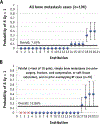Contemporary Statewide Practice Pattern Assessment of the Palliative Treatment of Bone Metastasis
- PMID: 29726364
- PMCID: PMC6844366
- DOI: 10.1016/j.ijrobp.2018.02.037
Contemporary Statewide Practice Pattern Assessment of the Palliative Treatment of Bone Metastasis
Abstract
Purpose: Palliative radiation therapy for bone metastases is often viewed as a single entity, despite national guidelines providing input principally only for painful uncomplicated bone metastases. Data surrounding the treatment of bone metastases are often gleaned from questionnaires of what providers would theoretically do in practice or from population-based data lacking critical granular information. We investigated the real-world treatment of bone metastases with radiation therapy.
Methods and materials: Twenty diverse institutions across the state of Michigan had data extracted for their 10 most recent cases of radiation therapy delivered for the treatment of bone metastases at their institution between January and February 2017. Uni- and multivariable binary logistic regression was used to assess the use of single fraction (8 Gy × 1) radiation therapy.
Results: A total of 196 cases were eligible for inclusion. Twenty-eight different fractionation schedules were identified. The most common schedule was 3 Gy × 10 fractions (n = 100; 51.0%), 4 Gy × 5 fractions (n = 32; 16.3%), and 8 Gy × 1 (n = 15; 7.7%). The significant predictors for the use of single fraction radiation therapy were the presence of oligometastatic disease (P = .008), previous overlapping radiation therapy (P = .050), and academic practice type (P = .039). Twenty-nine cases (14.8%) received >10 fractions (median 15, range 11-20). Intensity modulated radiation therapy was used in 14 cases (7.1%), stereotactic body radiation therapy in 11 (5.6%), and image guidance with cone beam computed tomography in 11 (5.6%). Of the cases of simple painful bone metastases (no previous surgery, spinal cord compression, fracture, soft tissue extension, or overlapping previous radiation therapy; n = 70), only 12.9% were treated with 8 Gy × 1.
Conclusions: Bone metastases represent a heterogeneous disease, and radiation therapy for bone metastases is similarly diverse. Future work is needed to understand the barriers to single fraction use, and clinical trials are necessary to establish appropriate guidelines for the breadth of this complex disease.
Copyright © 2018 Elsevier Inc. All rights reserved.
Conflict of interest statement
Conflict of interest:
Dr Pierce reports grants from Blue Cross and Blue Shield of Michigan and Blue Care Network during the conduct of the study.
Figures



References
-
- Chow E, Harris K, Fan G, et al. Palliative radiotherapy trials for bone metastases: A systematic review. J Clin Oncol 2007;25:1423–1436. - PubMed
-
- Maranzano E, Latini P. Effectiveness of radiation therapy without surgery in metastatic spinal cord compression: Final results from a prospective trial. Int J Radiat Oncol Biol Phys 1995;32:959–967. - PubMed
-
- Hoskin PJ, Grover A, Bhana R. Metastatic spinal cord compression: Radiotherapy outcome and dose fractionation. Radiother Oncol 2003; 68:175–180. - PubMed
-
- Ost P, Reynders D, Decaestecker K, et al. Surveillance or metastasis-directed therapy for oligometastatic prostate cancer recurrence: A prospective, randomized, multicenter phase II trial. J Clin Oncol 2018; 36:446–453. - PubMed
Publication types
MeSH terms
Grants and funding
LinkOut - more resources
Full Text Sources
Other Literature Sources
Medical

